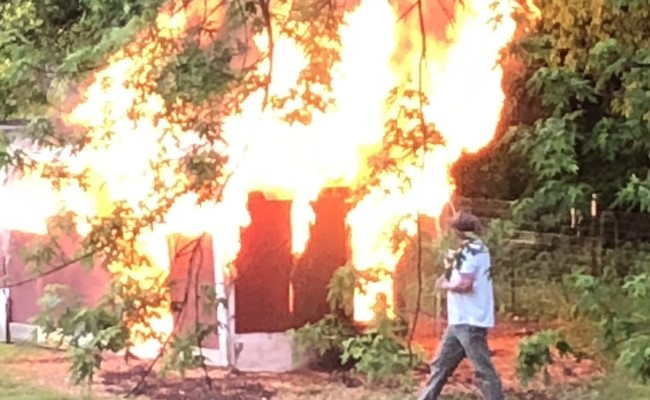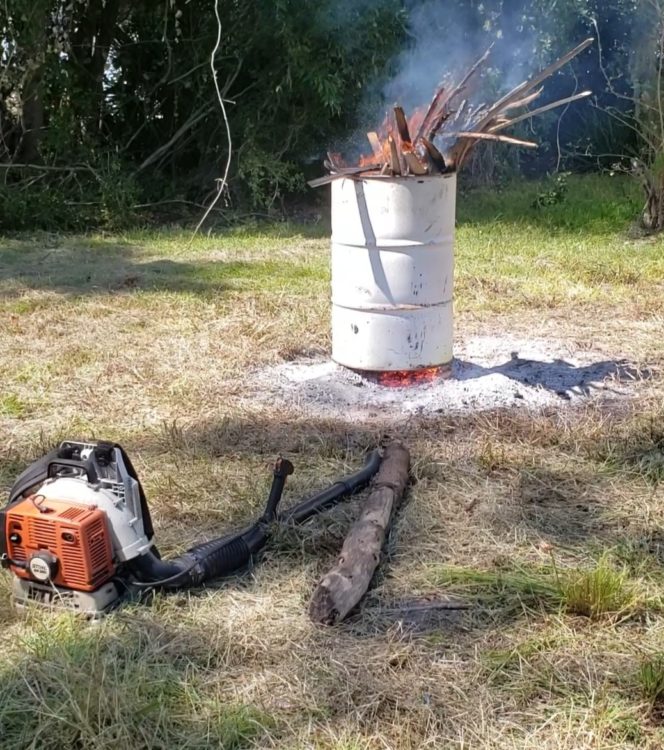
(For legal purposes, I have to say this is not advice. I do not recommend doing this in any way shape or form, nor do the owners of this blog, business, or any of its subsidiaries. This is a cautionary tale.)
I’m either a pyromaniac, lazy, or cheap. Most likely, it’s all three. I don’t want to dismantle a building and then discard the materials at a dump or recycling center. It’s time-consuming, expensive, and not all that fun. Plus, many recycling centers won’t take all the types of materials and going to the landfill can cost upwards of $100 per truck-bed to dump. So setting fire to my structures seems the easiest, albeit most dangerous, ways of destroying my old and dilapidated buildings.
The first was a chicken coop that didn’t quite meet the requirements of my chickens. It was too small, not enough air flow, and it was extremely hard to clean. So I built a better one in another area of the yard and then one night I moved all the chickens into the new coop and locked them in so they couldn’t escape (I didn’t want to cook a hen in the old coop).
First, I prepped the area. It was winter so I wasn’t too worried about spreading the flames (the nearest tree was about 200 feet away). Still, I moved any straw sticks and straw bales, kept my cars and gas cans a long way away, and made sure I had my fire extinguisher ready. I poured one cup of gasoline into the old coop, onto the dried straw and pine shavings.
Next, I grabbed an old 2×4 about 10 feet long and set it in the coop (touching the gasoline-soaked straw). I streamed lighter fluid along the board to act as a fuse. One uses lighter fluid because it travels more slowly than gasoline, and gives you time to run away. I lit the fuse and ran.
Poof.
It caught fire right away and there was no roasted-chicken smell.
To keep the fire going, you need a good metal rake. Or even better, my personal favorite, a Potato Fork. They have four tongs, are sharp, and allow you to move boards and embers easily.
Watch the fire for as long as it takes to turn to ash, continually moving the old boards and roofing materials into the main flames. Depending on the structure and the amount of fuel you used, it could take an hour or several more.
The second time I burned down a structure was my even larger chicken coop. I had built it out of reclaimed garage doors, with ladders in the middle as roosts, and a trap-door floor which allowed me to clean it easily. But still, it wasn’t quite the right coop. Despite my best efforts, it was still hard to clean, there was little room for layer nests and, quite frankly, it was ugly.
This time it was summer, so I had to take more precautions. I waited until we had three straight days of rain and the tree leaves were filled with water. Still, I doused them with my garden hose just in case. I cleared the surrounding area again and prepped the coop with gasoline and lighter fluid, as I’d done the previous time.
But I poured a little too much gasoline this time. And underestimated the structure. Lesson learned: The larger the structure, the larger the flames.
Within a few minutes of ignition the fire was out of control. The roof held the flame in and turned it into a flaming oven. I could barely get within 20 feet.
I grabbed my garden hose and started spraying the flames from afar. It seemed fruitless, but the small stream actually did quell the flames a little. It would never have extinguished the fire. The watering of the boards did slow it down at least.
The fire was done in just a couple hours. No one was hurt. Nothing spread. And there was nothing left but metal brackets and hinges. I sprayed them too, so no curious farm animal would get burned while sniffing it.
These fires saved time. They saved money. But they also poured a bunch of filth into the environment and endangered my home and neighbors. This is not the way to destroy your old buildings. Take the time and do it right, or contact your local fire department. Many will demolish your buildings for free as part of their training exercises!
Ben North lives and writes from a homestead in Iowa.

Karl L says
Attachment
Know your local and state regs. In Georgia, pretty hefty fine for burning structures or finished building materials. But if you can, rock on with it. I use a burn barrel with a little help from a backpack blower instilling air (at idle) into the bottom. Burns alot faster with little or NO smoke. That way no one sees what I am doing…
Ronnie Maeker says
Is this another “OH Thee, not me”?
If you shouldn’t, why did ya?
Joe Joe says
Yes you can burn a structure, NEVER use an accelerant like gasoline and lighter fuel ( like you found out with a relatively small coop). Since you ran, you don’t have the skillset. Ironic tho , firefighters would have come running! The safest way to burn anything is dismantle it and feed slowly in a designated area, where wind and embers won’t be an issue…. total control
Alan says
As a firefighter. I want to repeat this ! Never ever use gasoline to light any fire. The fumes are to volatile and explosive to use in a so called control burn. The author was lucky it didn’t exploded. Yes contact local authorities / fire department if your rural to see they want to use it for practice. They will also tell you if it’s even legal to have a “controlled burn”. In many states you need a permit and a waiver from dept of environmental protection. If you don’t have these I’s dotted and T’s crossed you could end up paying hefty fines that making a dump fee seem cheap .
Vincent Haugen says
Don’t use gasoline. Diesel is much less volatile and will produce the desired results.
Of course this method should never be attempted in built up areas or where any fire could spread to neighboring property. And even if they won’t burn it for you, still contact the local fire dept. Just in case things get out of hand. I’ve done similar burns of derelict structures and while it was never a problem, alerting the local fire dept and sherriff’s office are a good idea. And there could be a burn ban or other prohibitions you need to know about. Usually it is legal to burn in rural areas, no use in setting yourself up for legal problems or fines. Something else to consider. Rats. I’ve seen rats come flaming out of burning buildings several times. You do not want a flaming rat running into or under another structure or hay stack.
Had an old barn that was too far gone on the property when I purchased it. Pulled it down with the team of horses and some chains. Pilled the remains and burned the pile. No collapsing structure, no rats in the building, and was able to salvage several nice, still good timbers.
gunnygil says
Gasoline does not burn, the fumes burn. If you want or have nothing else to use as an accelerant to use but gasoline. To start a fire safely douse the material to be burned and wait about 20 minutes for the liquid to soak in and the fumes to dissipate then throw a match,. It will catch fire fast but not explode like this idiot did even using the lighter fluid as a “fuse”.
lefty says
inform your local police and fire department and get their permission BEFORE doing a burn. Avoids hassles with neighbors or busybodies.
Avoid windy conditions
William keith says
Never, never, never, use gasoline to start a fire!!
John Militano says
You must live in a pretty rural area to be able to contemplate even burning as an option. Glad your “controlled burns” panned out but I wouldn’t even of given that method a thought. I agree get the fire department to tear down an old barn for practice if they would. But it’s gonna cost ya to clean up either way. Just saying